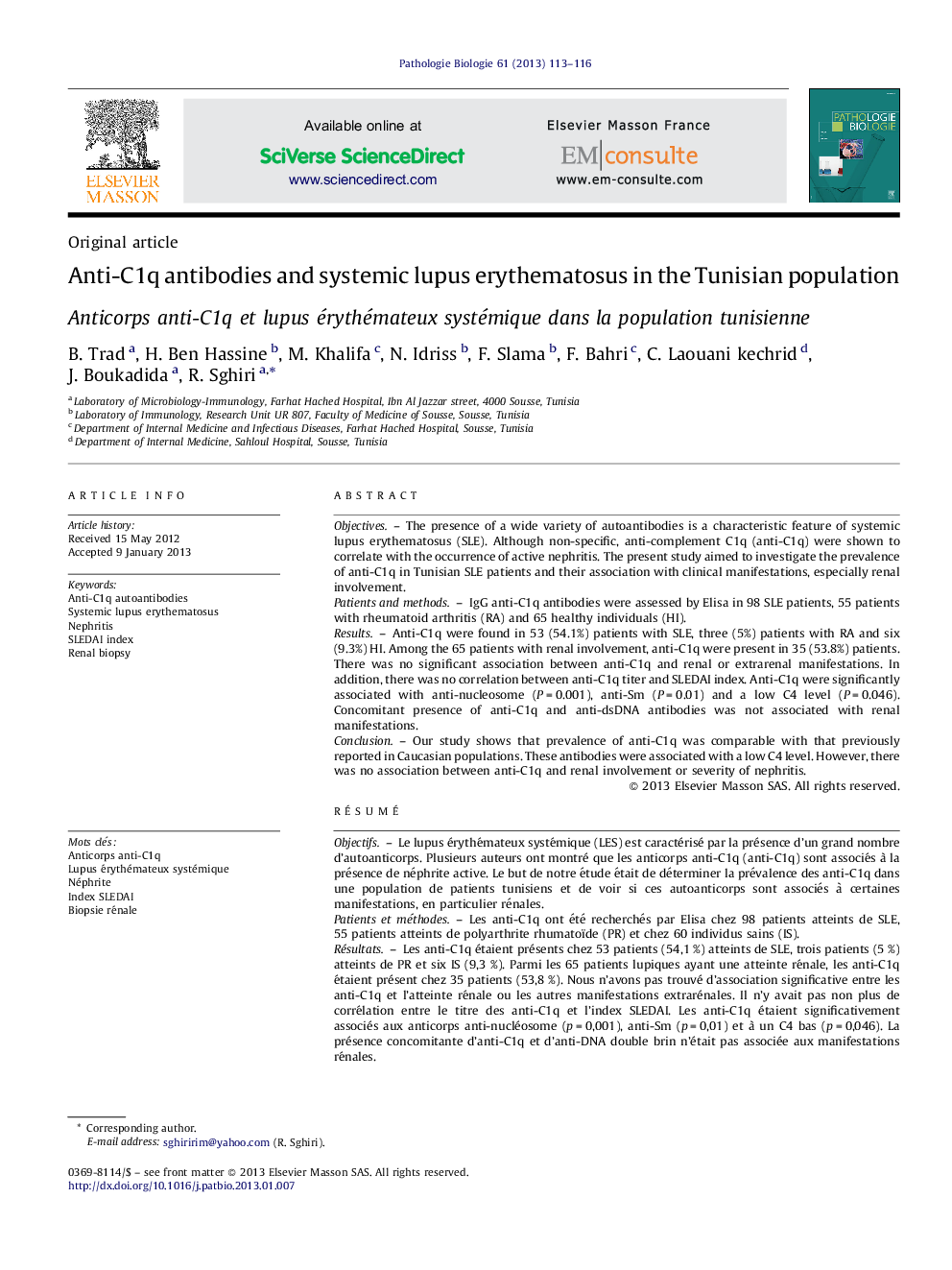| کد مقاله | کد نشریه | سال انتشار | مقاله انگلیسی | نسخه تمام متن |
|---|---|---|---|---|
| 6216347 | 1271890 | 2013 | 4 صفحه PDF | دانلود رایگان |

ObjectivesThe presence of a wide variety of autoantibodies is a characteristic feature of systemic lupus erythematosus (SLE). Although non-specific, anti-complement C1q (anti-C1q) were shown to correlate with the occurrence of active nephritis. The present study aimed to investigate the prevalence of anti-C1q in Tunisian SLE patients and their association with clinical manifestations, especially renal involvement.Patients and methodsIgG anti-C1q antibodies were assessed by Elisa in 98 SLE patients, 55 patients with rheumatoid arthritis (RA) and 65 healthy individuals (HI).ResultsAnti-C1q were found in 53 (54.1%) patients with SLE, three (5%) patients with RA and six (9.3%) HI. Among the 65 patients with renal involvement, anti-C1q were present in 35 (53.8%) patients. There was no significant association between anti-C1q and renal or extrarenal manifestations. In addition, there was no correlation between anti-C1q titer and SLEDAI index. Anti-C1q were significantly associated with anti-nucleosome (PÂ =Â 0.001), anti-Sm (PÂ =Â 0.01) and a low C4 level (PÂ =Â 0.046). Concomitant presence of anti-C1q and anti-dsDNA antibodies was not associated with renal manifestations.ConclusionOur study shows that prevalence of anti-C1q was comparable with that previously reported in Caucasian populations. These antibodies were associated with a low C4 level. However, there was no association between anti-C1q and renal involvement or severity of nephritis.
RésuméObjectifsLe lupus érythémateux systémique (LES) est caractérisé par la présence d'un grand nombre d'autoanticorps. Plusieurs auteurs ont montré que les anticorps anti-C1q (anti-C1q) sont associés à la présence de néphrite active. Le but de notre étude était de déterminer la prévalence des anti-C1q dans une population de patients tunisiens et de voir si ces autoanticorps sont associés à certaines manifestations, en particulier rénales.Patients et méthodesLes anti-C1q ont été recherchés par Elisa chez 98 patients atteints de SLE, 55 patients atteints de polyarthrite rhumatoïde (PR) et chez 60 individus sains (IS).RésultatsLes anti-C1q étaient présents chez 53 patients (54,1 %) atteints de SLE, trois patients (5 %) atteints de PR et six IS (9,3 %). Parmi les 65 patients lupiques ayant une atteinte rénale, les anti-C1q étaient présent chez 35 patients (53,8 %). Nous n'avons pas trouvé d'association significative entre les anti-C1q et l'atteinte rénale ou les autres manifestations extrarénales. Il n'y avait pas non plus de corrélation entre le titre des anti-C1q et l'index SLEDAI. Les anti-C1q étaient significativement associés aux anticorps anti-nucléosome (p = 0,001), anti-Sm (p = 0,01) et à un C4 bas (p = 0,046). La présence concomitante d'anti-C1q et d'anti-DNA double brin n'était pas associée aux manifestations rénales.ConclusionNotre étude montre que la prévalence des anti-C1q est comparable à celle rapportée dans les populations caucasiennes. Les anti-C1q étaient associés à un C4 bas. Comme d'autres auteurs, nous n'avons pas trouvé d'association entre ces anticorps et l'atteinte rénale.
Journal: Pathologie Biologie - Volume 61, Issue 3, June 2013, Pages 113-116